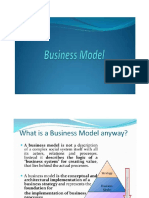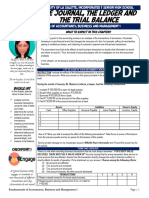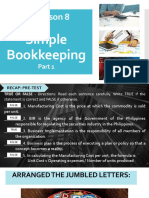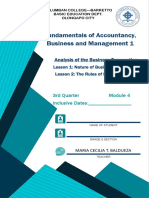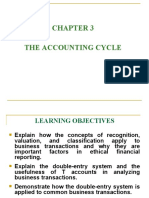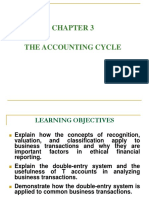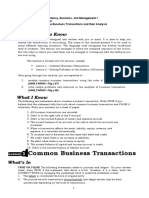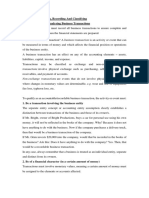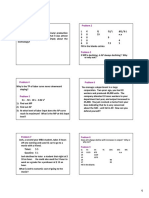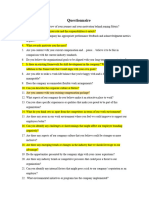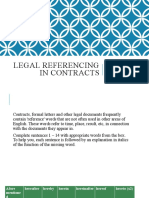FUNDAMENTALS OF ACCOUNTANCY, BUSINESS, AND MANAGEMENT 2 -
LESSON 1
TOPIC: RULES OF DEBIT AND CREDIT
Five Major Accounts
● assets ● owner’s equity ● expenses
● liabilities ● income
Journals
● used to record business transactions and show the amount debited and
credited
Ledger
● summarizes the ending balances of every account used by the business
Double-Entry System
● recording the changes in at least two accounts
● the amount in the debit and credit side must always be equal
Account
● tracks the asset, liability, owner’s equity, income, or expense
● records the increases and decreases
● stored in a general ledger or in a T-Account
T-Account
● a graphical representation of a ledger
● defines the appearance of the bookkeeping entries
Rules of Debit and Credit
Every account recorded in the debit
or credit side signifies an increase or
decrease in the balances of the
accounts
1
� Rules for Balance Sheet Accounts
Balance Sheet
● shows the financial position of a business in a specific time period
● presents the assets, liabilities, and owner’s equity
Assets
● objects or entities that the company owns
● have an economic value
Increase in Asset- recorded on the debit side
Decrease in Asset- recorded on the credit side
Contra-Assets
● accounts that reduce the value of its related asset account
● an increase in a contra-asset is recorded as a credit
Liabilities
● debts or obligations of an entity to other individuals or companies
Increase in Liability- recorded on the credit side
Decrease in Liability- recorded on the debit side
Equity
● the owner's rights to the business's assets
Increase in Equity- recorded on the credit side
Decrease in Equity- recorded on the debit side
Equity – Drawing
● a withdrawal by the owner decreases the owner's equity
2
� ● an increase in drawing is recorded on the debit side
Rules for Income Statement Accounts
Income Statement Accounts
● shows the financial position of a business in a specific time period
● presents the company’s income and expenses
Income Account
● comprises the actual earnings of a business over a period of time
● cash or check
Increase in Income- recorded on the credit side
Decrease in Income- recorded on the debit side
Expense Account
● costs incurred from operating activities during a specified accounting period
● decrease in owner’s equity
Increase in Expense- recorded on the debit side
Decrease in Expense- recorded on the credit side
Normal Balances of an Account
● the side of an account, either a debit or a credit, where increases are recorded
3
� Green Rose Center for Academe Inc.
Purok Gemelina Estaca Compostela Cebu
Mobile No. 0933-1617936 / Landline No. (032) 425-6216
E-mail add: greenroseacademe_119@yahoo.com, Website: http://grca.school
Government Recognition No:
PRE-ELEM: 04 S. 2017, ELEMENTARY: 5, S. 2017, JHS: 06, S.2017, SHS: 059 S.2018
School ID: 408281
FUNDAMENTALS OF ACCOUNTANCY, BUSINESS, AND MANAGEMENT 2 -
DRILL 1
(Topic: Rules of Debit and Credit)
Name: _____________________________Gr. & Sec. _________Date: ________
Parent’s Signature: ________________ Score: _________________
Identify whether the following effects should be recorded on the debit or credit side
of an account.
Effect Debit or Credit
1. Increase in supplies
2. Decrease in accounts payable
3. Increase in service revenue
4. Increase in accumulated depreciation
5. Decrease in cash
Effect Debit or Credit
6. Decrease in accounts receivable
7. Increase in accounts payable
8. Increase in utilities expense
9. Increase in prepaid expense
10. Increase in withdrawals
4
� FUNDAMENTALS OF ACCOUNTANCY, BUSINESS, AND MANAGEMENT 2 -
LESSON 2
TOPIC: SIMPLE BUSINESS TRANSACTIONS
● Business transactions refer to activities and events that affect the financial
position of an entity.
○ buying
○ selling
○ borrowing money
○ collecting obligations
○ utilizing assets
Characteristics of Business Transactions
Has Financial Value
● an amount that is payable in cash or other assets
● supported by the monetary unit concept
Supported by Source Documents
● evidenced by receipts, sales invoice, vouchers, etc.
5
� ● objectivity principle: recorded transactions must be based on solid evidence
Has Effect on Financial Position
● must balance the accounting equation
○ increase or decrease in assets, liabilities, or equity
Analyzing Business Transactions
Transaction Accounts Classification Changes
Affected
Received cash cash asset account Increase
from the owners
as an investment
capital owner’s equity Increase
account
Paid cash for supplies asset account Increase
supplies
cash asset account Decrease
Bought supplies supplies asset account Increase
on account
6
� accounts payable liability account Increase
to supplier
Paid cash on accounts payable liability account Decrease
account to supplier
Cash asset account Decrease
Transaction Accounts Classification Changes
Affected
Received cash Cash asset account Increase
from sales
Sales owner’s equity Increase
Paid cash for an Expenses owner’s equity Decrease
expense
Cash asset account Decrease
Paid cash to Drawings owner’s equity Decrease
owner
Cash asset account Decrease
● Business transactions are events and activities that affect the financial
position of an entity. Business transactions must have a monetary value,
supported by documentary evidence, and affect a business's financial
position.
7
�8
� Green Rose Center for Academe Inc.
Purok Gemelina Estaca Compostela Cebu
Mobile No. 0933-1617936 / Landline No. (032) 425-6216
E-mail add: greenroseacademe_119@yahoo.com, Website: http://grca.school
Government Recognition No:
PRE-ELEM: 04 S. 2017, ELEMENTARY: 5, S. 2017, JHS: 06, S.2017, SHS: 059 S.2018
School ID: 408281
FUNDAMENTALS OF ACCOUNTANCY, BUSINESS, AND MANAGEMENT 2 -
DRILL 2
(Topic: Simple Business Transactions)
Name: _____________________________Gr. & Sec. _________Date: ________
Parent’s Signature: ________________ Score: _________________
Directions: Write true if the statement is correct. Otherwise, write false.
1. A valid business transaction affects the accounting equation.
2. All business transactions involve an exchange of money.
3. Business activity can be recognized as a business transaction even though
there is no documentary evidence.
4. Regardless of its type and form, a business cannot operate without business
transactions.
5. When an asset is used in a company's operations, it can be recorded as a
business transaction.
Directions: Analyze each business activity. Explain its validity in terms of the
characteristics of business transactions.
1. Recorded Voucher No. 21 as payment for a three-month subscription to a
newspaper (₱8,000) and issued Check No. 21 to settle this voucher
Financial
value
Supporting
Documents
Effect on
Financial
Position
9
� FUNDAMENTALS OF ACCOUNTANCY, BUSINESS, AND MANAGEMENT 2 -
LESSON 3
TOPIC: BUSINESS DOCUMENTS
Business Documents
Managing a business comes with constant and never ending paperwork. Business success
starts with clerical and record-keeping work.
Financial reports should remain unbiased. They require solid evidence in the form of
business documents.
Accountants look at the accountable form, or business document, before recording the
transactions in the book of accounts.
● a source document
● used as evidence of the terms and conditions of a transaction
● parties receive different forms for every transaction
● usually contain the following:
● a description of the ● a specific amount
business transaction
● an authorized signature
● the transaction date
● a standard form for regular and repetitive transactions:
● paying for supplies ● paying cash for an expense
● buying supplies on account ● withdrawing cash
● receiving cash from sales
Official Receipt
● a written evidence of sale of services or lease of properties
● can be in the form of a cash receipt or service invoice.
Cash Receipt- acknowledgment that the company received cash or a check in exchange
for the services
Service Invoice- a billing statement if the service is on credit
Sales Invoice
10
� ● issued by a business as proof of ● attached to a statement of account
goods sold
Cash Invoice- if the sale is paid in cash
Collection Receipt- if the sale was made on credit, and upon payment by the client
Check Voucher
● issued when a business writes a check to pay its supplier.
● proof that the company has made a check payment
Purchase Order
● when a company orders from a vendor or supplier
● outlines what the order and delivery date
Delivery Receipt
● supports the sale of goods by the company
● the customer acknowledges the product purchased upon delivery
Business documents or source documents serve as evidence of the terms and
conditions between two parties engaged in a business transaction. Bookkeepers
analyze these documents before recording transactions into accounts.
Business documents contain the following:
o a description of the business o a specific amount
transaction o and an authorized signature
o the transaction date
The common types of business documents are:
o official receipts as proof of services rendered to a client
o sales invoices as proof of goods sold
o check or cash vouchers as proof of payment to the supplier
o purchase orders that detail the orders made by a business from a supplier
o delivery receipt as proof of delivery of products ordered by the client
11
� Green Rose Center for Academe Inc.
Purok Gemelina Estaca Compostela Cebu
Mobile No. 0933-1617936 / Landline No. (032) 425-6216
E-mail add: greenroseacademe_119@yahoo.com, Website: http://grca.school
Government Recognition No:
PRE-ELEM: 04 S. 2017, ELEMENTARY: 5, S. 2017, JHS: 06, S.2017, SHS: 059 S.2018
School ID: 408281
FUNDAMENTALS OF ACCOUNTANCY, BUSINESS, AND MANAGEMENT 2 -
DRILL 3
(Topic: Business Documents)
Name: _____________________________Gr. & Sec. _________Date: ________
Parent’s Signature: ________________ Score: _________________
Directions: Identify the business documents that should be issued in every
transaction and explain why.
1. Mr. Kruz is the owner of a car repair shop. The business provides a
maintenance service to a client for ₱17,500.00 to be settled after a week.
What business document should Mr. Kruz give the client? Explain your
answer.
12
� 2. Alpha Med Supplies is a provider of medical equipment to hospitals. The
company sold and delivered medical supplies to St. John Hospital. The
business received a check for ₱275,000.00 as payment for the acquired
supplies. What business documents should Alpha Med give the client? Explain
your answer.
FUNDAMENTALS OF ACCOUNTANCY, BUSINESS, AND MANAGEMENT 2 -
LESSON 4
TOPIC: INTRODUCTION TO SERVICE BUSINESSES
What is a service business?
Service
● happens when someone performs a service for others in exchange for a fee,
remuneration, or consideration, whether in cash or kind
● activities that other individuals and companies do for their customers
● actions that the government does for their citizens
● provides intangible products
● offer professional skills, expertise, advice, and the like
Examples of Service Businesses
Professional Personal and support Entertainment and Leisure
● accounting and finance ● repairs ● hotels
● legal ● rentals ● gaming
13
� ● research ● laundry ● amusement parks
● engineering ● beauty ● media broadcast
● other essential services
Public Service
● police and armed forces ● public healthcare
● paramedics ● waste management
● fire brigade ● urban planning
● A company can be a service business, a manufacturing business, or a
merchandising business simultaneously.
Nature of Service Business
14
�Intangibility
● service cannot be touched, handled, transported, stocked, manufactured,
mined, or farmed
● service cannot be touched, handled, transported, stocked, manufactured,
mined, or farmed
Inventory
● service cannot be stored for future use
● service irreversibly vanishes when done
● also known as perishability
Inseparability
● delivery and service cannot be separated; the provider must deliver the
service at the time of consumption
● delivery of a particular service is never the same as the previous or future
ones
● also known as variability
15
�Involvement
● both the consumer and provider of service participate in the provision of the
service
● Unless both are present, the service cannot be done.
Types of Documents for Service Businesses
Official Receipt- service businesses provide Official Receipts as proof of services provided
to the customers
Sales Invoice - provided to customers as proof of goods sold to customers
Source documents are important to bookkeepers and accountants to keep track of
the business activities. They are also used by auditors to confirm the validity of
transactions.
Oftentimes, source documents show the description of the transaction, the date,
total amount and/or quantity being availed, and the authorized individuals involved
in the sale. Whether involving goods or services, source documents always play a
role in the accounting process.
Some examples of source documents frequently used are:
● Memorandums
● Receipts
● Checks
● Slips
The International Financial Reporting Standards (IFRS) is promulgated by the
International Accounting Standards Board (IASB) to guide the business
community on proper accounting across different industries. It also fosters
standardization and uniformity of accounting for concerned professionals to
follow.
Recently, the IASB released IFRS 15, named Revenue from Contracts to
Customers. As business structures continue to develop and become more
complex worldwide, many types of transactions are often merged to ease
customers and boost business innovation.
The IFRS 15 aims to clarify and separate these differentiated transactions to
facilitate better accounting.
16
� With the implementation of IFRS 15, variations across different industries in how
similar transactions are handled are eliminated.
This is important because the lack of fundamental concepts and standardization
in the preparation of financial statements impairs the users of the information to
make informed judgments.
The complexity and vagueness of financial data make it difficult for investors and
relevant authorities to assess and compare businesses.
Because of this, the IFRS 15 stated several steps on how to assess contracts
with customers and differentiate separable transactions.
Although the IFRS 15 is one of the confusing standards that accountancy and
business students must familiarize, it goes back to the basic concept of
identifying and classifying business transactions.
● A service type of business provides intangible products (products with no
physical form). They offer professional skills, expertise, advice, and other
similar products.
● An Official Receipt is issued to the customer as proof of the receipt of
cash/payment for the service provided to him/her. On the other hand, a Sales
Invoice is issued to the customers as proof of the sale of goods and the
establishment of Accounts Receivable, as the cash payment has not yet been
received.
Green Rose Center for Academe Inc.
Purok Gemelina Estaca Compostela Cebu
Mobile No. 0933-1617936 / Landline No. (032) 425-6216
E-mail add: greenroseacademe_119@yahoo.com, Website: http://grca.school
Government Recognition No:
PRE-ELEM: 04 S. 2017, ELEMENTARY: 5, S. 2017, JHS: 06, S.2017, SHS: 059 S.2018
School ID: 408281
FUNDAMENTALS OF ACCOUNTANCY, BUSINESS, AND MANAGEMENT 2 -
DRILL 4
(Topic: Introduction to Service Businesses)
Name: _____________________________Gr. & Sec. _________Date: ________
Parent’s Signature: ________________ Score: _________________
Directions: Write True on the blank if the statement bears the correct
thought. Otherwise, write False.
1. A service business provides intangible products.
2. Services are substantiated by Sales Invoices.
3. Sale of goods are substantiated by Official Receipts.
17
� 4. Intangibility of a service means that it cannot be touched,
handled, transported, stocked, manufactured, mined, or
farmed.
5. Inseparability of services means that it cannot be stored
for future use. Once the service is done, it irreversibly
vanishes.
6. Inconsistency means that the delivery of a particular type of
service is always unique.
7. One of the five “I’s” of service is “incapacity”.
8. An accounting firm is an example of a service business.
9. A service business offers professional skills, expertise,
advice, and other similar products.
10. Sale of medicines by a pharmacy is an example of sale of
service.
Directions: Fill in the blanks with the correct answer.
1. The customer does not own any _______________as a result of a
service transaction.
2. An exchange of service happens when someone performs a service
for others in exchange for a _____________________________.
3. Inventory means that the service cannot be stored for ___________use .
4. Service business provides ________________to evidence transactions.
FUNDAMENTALS OF ACCOUNTANCY, BUSINESS, AND MANAGEMENT
2 - LESSON 5
TOPIC: ACCOUNTING CYCLE FOR SERVICE-TYPE BUSINESSES:
JOURNALIZING
Figure 1: Basic Recording Process
18
�The rules of debit and credit are the fundamental principles of the modern double-
entry accounting system. These rules are used by accountants and bookkeepers in
journalizing transactions and completing the accounting cycle.
Account Type Normal Balance Increase Decrease
Asset Debit Debit Credit
Liability Credit Credit Debit
Equity Credit Credit Debit
Contra Opposite to Nominal Credit (if normal Debit (if normal
Account balance of contra balance of contra
account is credit) account is credit)
Debit (if normal Credit (if normal
balance of contra balance of contra
account is debit) account is debit)
Revenue Credit Credit Debit
Expense Debit Debit Credit
Asset Accounts
are real (permanent) accounts that have a normal debit balance, and thus inflows
and/or additional assets are debited.
● Cash ● Supplies
● Accounts Receivable ● PPE (property, plant, and
equipment)
● Notes Receivable
● Prepayments
Liability Accounts
are real accounts that have a normal credit balance, and thus additional liabilities
incurred are credited and eventual settlement of them is debited in the journal.
● Accounts Payable ● Bonds Payable
● Notes Payable ● Mortgage Payable
● Utilities Payable ● Advances from Customers
● Loans Payable
19
�Equity Accounts
are real accounts that have a normal credit balance; thus, all relevant events that
affect an increase in equity are credited and reductions are debited.
● Initial and subsequent investments
● Profit/Loss
Contra Accounts
are opposite the account's normal balance they relate to, thus reducing the natural
account they correspond to.
● Allowance for Doubtful Accounts are reductions in estimating Accounts
Receivable
Revenue
Increases in Revenues are credited
● Service Revenue
● Consultation Fees
● Interest Revenue
Expenses
increases in Expenses are debited
● Salaries
● Rent
● Utilities
● Taxes
● Depreciation
Recording Service Transactions in the General Journal
General Journal
● a form for recording transactions in chronological order
20
� ● businesses should book all their transactions in the general journals
Journalizing
● the process of recording the financial transaction of a business
● accountants analyze financial transactions before the information is recorded
the simplest and most commonly used is the two-column general journal:
General Journal Page
Date Account Title and Description Ref Debit Credit
Example:
On June 19, JA Varal Accounting Firm provided consulting services to its clients in
the amount of P100,000, the journal entry to record the transaction should be:
General Journal Page
Date Account Title and Description Ref Debit Credit
June 19 Cash 100,000
Consulting Fees
100,000
Recording Transactions
● Must be supported by invoices
● Must be recorded chronologically
● Must properly reflect all increases and decreases to an account in the journals
through an entry
Recording Advances and Prepayments
● common accounts involved in service businesses
● Prepayments: asset accounts that are advanced payments before the
company consumes a product
21
� ● Advances from Customers are liabilities which are early payments from
customers before the company renders the services
Recording Nominal Accounts
● must properly reflect all increases and decreases in the journals through an
entry
○ Revenues have a normal credit balance
○ Expenses have a normal debit balance
● For Statement of Financial Position accounts of service businesses, increases
or inflow of assets are debited in the general journal. On the other hand,
increases in Liabilities and Equity are credited. Meanwhile, contra accounts
are recorded oppositely in relation to their corresponding accounts.
● For Statement of Comprehensive Income accounts, increases in Revenues are
debited, and increases in Expenses are debited.
● In double-entry accounting, the debits should equal the credit sides of the
transactions. Debits must equal Credits.
● Source documents are necessary to support the recording of financial
transactions of the business.
● A common source document for service businesses is the Official Receipt.
Green Rose Center for Academe Inc.
Purok Gemelina Estaca Compostela Cebu
Mobile No. 0933-1617936 / Landline No. (032) 425-6216
E-mail add: greenroseacademe_119@yahoo.com, Website: http://grca.school
Government Recognition No:
PRE-ELEM: 04 S. 2017, ELEMENTARY: 5, S. 2017, JHS: 06, S.2017, SHS: 059 S.2018
School ID: 408281
FUNDAMENTALS OF ACCOUNTANCY, BUSINESS, AND MANAGEMENT 2 -
DRILL 5
(Topic: Accounting Cycle for Service-Type Businesses: Journalizing)
Name: _____________________________Gr. & Sec. _________Date: ________
Parent’s Signature: ________________ Score: _________________
22
�Directions: Journalize the transactions using a general journal.
Provided below are the February 20x2 transactions of Queen Co.:
Feb. 12 - Paid cash for rent, ₱ 600.00
13 - Received cash from sale of services, ₱ 500.00
14 - Sold services on account to Peasant Company,
Php450.00
15 - Paid cash for telephone bill, ₱ 225.00
19 - Paid cash for postage (Miscellaneous Expense),
₱ 64.00
25 - Bought supplies on account from King Supplies,
₱ 76.00
Answer the following questions:
1. Why does a general journal consist of a general debit and a general credit?
What is the rationale behind this?
2. What is the difference between Prepayments and Advances from Customers?
FUNDAMENTALS OF ACCOUNTANCY, BUSINESS, AND MANAGEMENT
2 - LESSON 6
TOPIC: ACCOUNTING CYCLE FOR SERVICE-TYPE BUSINESSES:
LEDGERS AND T-ACCOUNTS
General Ledger
● Summarizes transactions from the general journal
● Known as a “Book of final entry”
● Composed of assets, liabilities, equity, income and expense accounts
● Organizes transactions by account instead of dates
23
� Chart of Accounts
● List of all accounts with its corresponding account numbers
● Used by accountants to analyze transactions
● Accounts may be added if not listed in the Chart of Accounts
Account numbers may have a two-digit or a three-digit number.
● Assets starts with 1;
● Liabilities with 2;
● Equities with 3;
● Income with 4;
● Expenses with 5.
T-account
● Simplest form of an account
● Has the same purpose as the General Ledger
● Looks like the letter “T”
● Helps visualize the effect of double-entry accounting
24
� A T-account has four parts:
● The account title
● The debit (left) side
● The credit (right) side
● The balance of the account
○ The excess of the debits or credits
Posting Transactions to the General Ledger
● Requires diligence
● All journal entries are transferred to general ledger
● Use cross-referencing
● No new information must be added
● Debit and credit should always equal
Steps in Posting to the General Ledger
1. Write the column headings.
2. Copy the beginning balances.
3. Copy the date.
4. Write the posting reference after posting to the ledger.
5. If the journal entry is a debit, post it to the debit side of the ledger. If the
journal entry is credited, post it on the credit side of the ledger.
6. Write the posting reference column in the journal.
7. Repeat the steps until all transactions are posted.
25
� 8. Foot the debit and credit.
9. Compute the ledger balances.
Process is similar to posting to the ledger, but with fewer steps
Can be used to prepare adjusting entries
Steps in Posting to the T-Accounts
1. Draw a large “T”.
2. Write the account title at the top of the T-account.
3. Copy the beginning balances
4. Copy the date
5. Write the posting reference after posting to the ledger.
6. If the journal entry is a debit, post it to the debit side of the ledger. If the
journal entry is credited, post it on the credit side of the ledger
7. Repeat the steps until all transactions are posted.
8. Foot the debit and credit.
9. Compute the balances.
● Posting refers to transferring the transactions from the general journal to
the general ledger. A general ledger is a record of accounts that classifies
and summarizes transactions from the general journal.
● A Chart of Accounts lists all accounts with their corresponding account
numbers.
● The T-account is the simplest form of account. It serves the same purpose
as the General Ledger but with less information compared to the latter.
According to the double-entry bookkeeping system, a t-account may help an
accountant analyze a business transaction.
● The critical rule in posting is to make sure that all transactions are posted
accurately.
● It is essential to know how to post transactions and prepare financial records
manually because computerized accounting systems may be subject to data
loss and data corruption.
26
� Green Rose Center for Academe Inc.
Purok Gemelina Estaca Compostela Cebu
Mobile No. 0933-1617936 / Landline No. (032) 425-6216
E-mail add: greenroseacademe_119@yahoo.com, Website: http://grca.school
Government Recognition No:
PRE-ELEM: 04 S. 2017, ELEMENTARY: 5, S. 2017, JHS: 06, S.2017, SHS: 059 S.2018
School ID: 408281
FUNDAMENTALS OF ACCOUNTANCY, BUSINESS, AND MANAGEMENT 2 -
DRILL 6
(Topic: Accounting Cycle for Service-Type Businesses: Ledgers and T-Accounts)
Name: _____________________________Gr. & Sec. _________Date: ________
Parent’s Signature: ________________ Score: _________________
Directions: Do as directed.
Marie is the owner of Pretty Accounting Office, a business that offers bookkeeping
services to its clients. Marie is preparing the 20x2 financial statements, and she
gathered the following account balances as of December 31, 20x2.
Cash ₱25,000
Equipment 40,000
Unearned Service Revenue 20,000
Marie, Capital 45,000
During the year, the following transactions occurred:
January 3 Performed services on account to Ruth Company amounting to ₱3,000
25 Received cash from Fati Company for services rendered during January,
₱15,000
31 Paid rent for the month of January to Nicole Company, ₱5,000.
27
�Answer the following:
1. Prepare the journal entries for the January transactions of the Pretty
Accounting Office.
2. Post the related transactions to T-accounts.
28

















